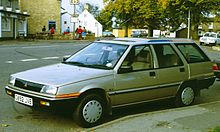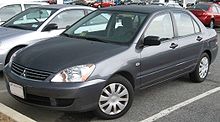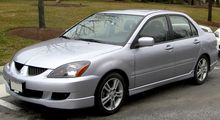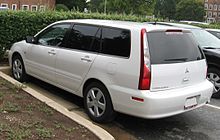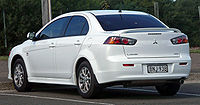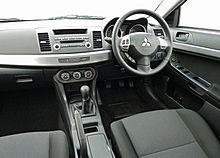- Mitsubishi Lancer
-
Mitsubishi Lancer 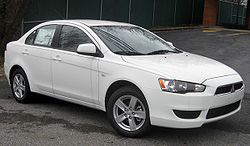
Manufacturer Mitsubishi Motors Production 1973–present Assembly Mizushima plant, Kurashiki, Okayama, Japan Predecessor Mitsubishi Mirage (for North America) Class Subcompact (1973–1999)
Compact (2000–present)The Mitsubishi Lancer is a family car built by Mitsubishi Motors. It has been known as the Colt Lancer, Dodge/Plymouth Colt, Chrysler Valiant Lancer, Chrysler Lancer, Eagle Summit, Hindustan Lancer, Soueast Lioncel, Mitsubishi Carisma, and Mitsubishi Mirage in various countries at different times, and has been sold as the Galant Fortis in Japan since 2007. It has also been sold as Lancer Fortis in Taiwan with a different facelift compared to Galant Fortis.
Between its introduction in 1973 and 2008, over six million Lancers had been sold.[1]
First generation (1973–1979)
The first Lancer (A70) was first launched in February 1973. It served to fill the gap between the Minica kei car and the larger Galant. The sporting 1600 GSR model began the Lancer's long and successful rally history, winning the Safari Rally twice and the Southern Cross Rally four times.
There were three body styles, two- and four-door sedans and a long-running five-door station wagon (built until replaced by the front-wheel drive Lancer/Mirage Van in March 1984). Engines were different 1.2 liter, 1.4 liter, and 1.6 liter fours.
This car was marketed under a variety of names:
- Dodge Colt (USA, 1977–1979)
- Dodge Lancer (some Latin American countries)
- Colt Lancer (Some European markets)
- Chrysler Valiant Lancer LA (Australia, 1974–1977)
- Chrysler Lancer LB (Australia, 1977–1980)
- Plymouth Colt (Canada)
Celeste
In February 1975 the Lancer was complemented by a liftback coupé called the "Mitsubishi Lancer Celeste", succeeding the Galant FTO. It was also called the "Mitsubishi Celeste" or "Colt Celeste" in some markets; and sold as the Chrysler Lancer Coupé (LB/LC) in Australia,[2] the Dodge Lancer Celeste in El Salvador, the Plymouth Arrow in the United States, and the Dodge Arrow in Canada.
The Celeste was originally available with 1.4- and 1.6-liter options, while a bigger 2.0-liter model was added later. An even larger 2.6-liter four was available in the US-market Plymouth Fire Arrow.[3] The Celeste was facelifted in 1978, receiving square headlights and bigger squarer bumpers.[4] Production of the Lancer Celeste ended in July 1981 and it was replaced by the front-wheel drive Cordia in early 1982.
Second generation (1979–1988)
Second generation 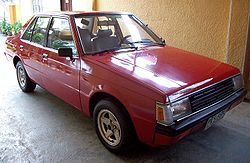
Production 1979–1988 Body style 4-door sedan Layout FR layout Platform A172A–A176A Engine 4G62 1.8 L SOHC Turbo I4
4G62 1.8 L SOHC I4
4G33 / 4G12 1.4 L SOHC I4
4G32 1.6 L SOHCl4
4G11 1.2 L SOHC l4
4G63 2.0 L OHC Turbo l4 (EX 2000 Turbo)Transmission 4-speed manual
5-speed manual
Automatic (1400/1600 - GL/XL, 1800 SE)Wheelbase 2,440 mm (96.1 in) Length 4,230 mm (166.5 in) Width 1,620 mm (63.8 in) Height 1,380–1,390 mm (54.3–54.7 in) Curb weight 1,170–1,295 kg (2,600–2,850 lb) Designer Aldo Sessano (design)
Rakuzo Mitamura (engineering)[5]In 1979, the Lancer EX was unveiled in Japan. Only two engines were offered at the time, a 1.4 L MCA-JET equipped engine paired with Mitsubishi's Silent Shaft Technology, which generated 80 hp (60 kW) and a 1.6 L engine that generated 85 hp (63 kW) and 100 hp (75 kW). The MCA-JET system was an entirely new concept when compared with the previously used carburetor system. The MCA stands for Mitsubishi Clean Air which meant that the EX passed both Japan and US emission standards, while the new cylinder head design of the engine gave way for a Jet valve which introduced an extra swirl of air to the combustion chamber, swirling the fuel-air mixture for a cleaner, efficient and more thorough burn.
In addition to these improvements, another breakthrough in the Lancer lineup was the Silent Shaft Technology, which was actually two counterbalancing shafts that rotated in opposite directions, cancelling the power pulses inherent in an inline 4 cylinder engine. This reduced both engine noise and vibration, and provided a smoother driving experience. The 1.8 L Sirius 80 engines were then introduced in the Lancer in 1980, along with a new 70 hp (52 kW), 1.2 L engine a year later, providing a broader range of engines for the Mitsubishi's Lancer. Also, a turbocharged, 135 PS (99 kW; 133 hp) engine was added in 1980 for sportier performance, and an Intercooler system was also integrated in the existing turbocharged engine to produce 165 PS (121 kW; 163 hp) in 1983.
Lancer EX 1800GSR and GT Turbo
In 1980, The Lancer EX was introduced with a 1.8 L turbocharged 4-cylinder option known as the 1800GSR and GT Turbo. The first generation 1800GSR and GT were only available with a turbocharged, non-intercooled 135 PS (99 kW; 133 hp). However, in 1983, an intercooler was introduced, helping the turbocharged engine to produce 160 PS (118 kW; 158 hp)..
Japan model and trim levels
- 1400SL - 4-door sedan powered by a 1.4L engine, with a 4-speed Manual Transmission. 5-speed was also introduced. (1979–1987)
- 1200SL - Same as the SL, with a 1.2L engine option. (1979–1983)
- 1400GL - 3-speed Automatic version of the SL (1979–1983)
- 1400SL A/T - Same as the GL, with minor changes. (1983–1987)
- 1600XL - 4-door sedan powered by a 1.6L engine, with a 3-speed Automatic Transmission. (1979–1983)
- 1600GSR - 4-door sedan powered by a 1.6L engine with twin carbs, with a 5-speed Manual Transmission. (1981–1983)
- 1600XL Super - Same as the XL, with minor changes. (1983–1987)
- 1800SE - 4-door sedan powered by a 1.8L producing 100 hp (75 kW) engine, and available with a 5-speed Manual Transmission or a 3-speed Automatic Transmission. (1981–1983)
- 1800GSR Turbo - 4-door sedan powered by a turbocharged 1.8L engine producing 135 PS (99 kW), with aesthetic upgrades.(1981–1983)
- 1800GT Turbo - Same as the GSR, but with a different body trim. (1981–1983)
- 1800GSR Turbo Intercooler - Intercooled version of the first turbo version, producing 160 PS (118 kW), and with minor changes to the aesthetics. (1983–1987)
- 1800GT Turbo Intercooler - Same as the GSR Turbo Intercooler, again with different body trim. (1983–1987)
- 1800GSL Turbo - Same as the GSR Turbo Intercooler, only it used the engine from the GSR/GT Turbo, and equipped with a 3-speed Automatic Transmission, and with a more luxurious interior. Along with an AM/FM Multi-Cassette Stereo System. (1983–1987)
Lancer EX 2000 Turbo
In Europe, the Lancer EX was offered with a turbocharged 2.0 L 4–cylinder engine known as the Lancer EX 2000 Turbo. It was the first Lancer to use the very first 4G63 engine which was then used in succeeding models such as the Galant VR-4 and the Lancer Evolution I to IX.
It achieved a maximum output of 170 PS (125 kW) and manages a top speed of 200 km/h (124 mph) and a quarter mile time of less than 15.5 s. A new feature on this model is that it is equipped with ECI or Advanced Electronically-Controlled Fuel Injection which gave the Lancer more power and outstanding fuel economy as it did 23.0 mpg in city driving and 28.8 to 37.2 mpg in highway driving. A rally version of the Lancer EX 2000 Turbo was made for the 1000 Lakes Rally that gave out 280 PS (206 kW; 276 hp). Sales of this model were low because of emission regulations Japan imposed at that time.
Philippines (1979–1989)
In The Philippines, the Lancer EX (which is popularly known as the Box Type Lancer) was offered with three variants. These variants are the SL, GSR, and GT. All engines were equipped with the Silent Shaft Technology (the SL had the 1.4 L while the GSR and GT had 1.6 L) and soon after, Automatic was available for SL and GSR variants. Sales stopped in 1989 since it was to be replaced by the fifth generation Lancer.
Model and trim levels
- SL - Base Model. 4-door sedan powered by a 1.4L engine with a 4-speed Manual Transmission and later introduced with the 1.2 L engine (4G11) alongside with the 3-speed Automatic Transmission
- GSR - Mid Range Model. 4-door sedan powered by a 1.6L engine with a 5-speed Manual Transmission. 3-speed Automatic Transmission along with a 1.8L engine option (4G62 - carb ver.) was then introduced.
- GT - Limited Edition version with the Lancer EX Turbo Bodykit, 14" alloy rims, and same 1.6L engine.
Other markets
The Lancer EX (the Lancer name was used, and excluding Japan) was sold throughout the Asia and the Pacific (Malaysia, Indonesia, China, Australia, New Zealand). It was also sold in South America.
Engines used
4G63
- ECI turbocharged DOHC 1997 cc (2.0L) I4, 170 hp (127 kW)
4G62/G62B
- ECI turbocharged SOHC 1795 cc (1.8L) I4, 160 hp (119 kW)
- ECI turbocharged (3rd gear) SOHC 1795 cc I4, 135 hp (101 kW)
- Carb SOHC 1795 cc I4, 100 hp (75 kW)
4G32/G32B
- Carb SOHC 1597 cc (1.6L) I4, 85 hp (63 kW)
4G33/G12B
- Carb "MCA-Jet" SOHC 1410 cc (1.4L) I4, 80 hp (60 kW)
4G11/G11B
- Carb SOHC 1244 cc (1.2L) I4, 54 hp (40 kW)
Third generation: Lancer Fiore (1982–1983)
Lancer Fiore (Third generation) Also called Mitsubishi Colt Sedan
Mitsubishi Lancer, Lancer F
Mitsubishi Mirage SaloonProduction 1982–1983
1982–1990 (Australia)Body style 4-door sedan Layout Front engine, front-wheel drive Platform A155A/A156A Engine 1.2 L Orion 4G11 I4
1.4 L Orion 4G12 I4 (NA or Turbo)In January 1982, a special model was launched called the Lancer Fiore, also known as third version of the Lancer, based on the A15#-series Mitsubishi Colt/Mirage. It's introduction coincided with the Mirage II facelift, from which the Fiore benefitted too. The Fiore was often sold as a Lancer in international markets, and also as the Mirage Saloon in Japan.[6] In Australia, it would eventually be sold as the Mitsubishi Colt Sedan although cosmetically different. Thus, Mitsubishi had two similarly sized models competing in the same market segment, sometimes even while sharing the "Lancer" badge.
It was available in the home market with 1,244 and 1,410 cc iterations of the familiar Orion, putting out 72 and 82 hp (53 and 60 kW).[7] A 105 hp (77 kW) 1400 GT Turbo was added in September 1982.[8]
The Lancer Fiore/Third generation was discontinued in October 1983 with the introduction of the fourth generation, not even two years after its launch. Production continued in Australia until 1990 (alongside the hatchback version), but labelled as "Mitsubishi Colt". The RWD Lancer EX outlasted it in most markets though.
Fourth generation (1983–1988)
Fourth generation 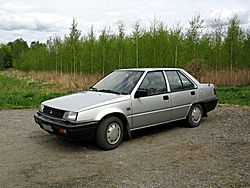
Also called Mitsubishi Mirage Production 1983–1988 Body style 4-door sedan
5-door station wagonLayout Front engine, front/four-wheel drive Platform C11A–C14A, C18A Engine 1,298 cc Orion 4G13 I4
1,468 cc Orion 4G15 I4
1,597 cc Saturn 4G32 I4
1,755 cc Saturn 4G37 I4 (4WD)
1,795 cc Sirius 4D65 I4Related Proton Saga
Proton IswaraWith the introduction of the C10 series, the Mirage Saloon and Lancer Fiore (just Lancer in the export) remained the same car. The new Lancer Fiore incorporated the latest in computer control engine technology including an electronic fuel injection for its high performance 1.6-litre turbocharged engine with a power output of 120ps. For the fuel conscious, a 1.8-litre "Sirius" diesel engine was added as well as the new 1.5-litre MD (Modulated Displacement) engine which was developed by Mitsubishi Motors and introduced to the market for the first time.
In 1985, the Lancer Wagon/Cargo (also marketed as the Mirage Wagon/Van) was introduced to address expanding user needs and to extend the versatility of the Lancer lineup. It had rather unusual, diagonal taillights. The following year saw the addition of a full-time four wheel drive Wagon version, with a 1.8-litre engine. This model went on to become very popular in both the commercial and private sectors overseas as well as in Japan. Since there was no wagon version of the fifth generation Mirage/Lancer, production of this one continued until 1991.
This model formed the basis of the original Proton sedan, the Saga, which was still in production until early 2008. However, in the Philippines, this generation of Lancer was not sold through Mitsubishi dealers.
Fifth generation (1988–1991)
Fifth generation 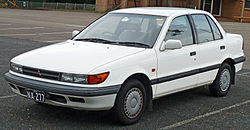
Production 1988–1991 Body style 3-door hatchback
4-door sedan
5-door hatchbackLayout Front engine, front-/four-wheel drive Platform C61A–C73A Engine 1.2l I4 4G16, 1.3l I4 12V 4G13, 1.5l I4 8V and 12V 4G15, 1.6l I4 16V 4G61, 1.8 diesel, 1.6 I4 16V 4G61T Turbo GSR, 1.8 l I4 16V 4G67. Wheelbase 2,455 mm (96.7 in) Related Mitsubishi Mirage
Dodge/Plymouth Colt
Eagle SummitDesigner Masaru Furukawa (design)
Yasukichi Akamatsu (engineering)[5]In 1988, a more aerodynamic-looking Lancer was launched, following the shape of the Galant. A five-door liftback was added to the range. The station wagon continued on the old platform and shape. In Japan, sedans and hatchbacks were available with either the Lancer or the Mirage nameplate, while hatchbacks were only sold as Mirages and liftbacks only as Lancers. In Australia, where the 1978 Mirage/Lancer Fiore was still produced as the Colt, all models of the new car were sold as the Mitsubishi Lancer, initially designated as the CA series and from 1990 as the CB. In Europe, four- and five-door versions were all called Lancer. Engines available in the European market ranged from the 65 hp 1.2-litre 4G16 (Greece only)[9] to a 136 hp 1.8-litre 16-valve, and included a 1.8-litre diesel.
In Japan, four-wheel drive versions were also available, fitted with a carburetted 1.5-liter, fuel injected 1.6-liter 16-valve, or with the 1.8 diesel. A GSR model with a fuel injected 1.6 litre turbocharged engine was also produced.
The CA/CB series five-door liftback version continued to be sold in Australia alongside the sixth generation (CC) Lancer from 1992 through to 1996. Confusingly, the carry-over liftback sold after 1992 was also given the "CC" model designation, as utilized by the subsequent model.[10][11]
Sixth generation (1991–1995)
Sixth generation 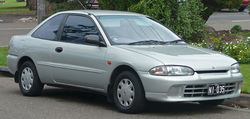
Production 1991–1995 Body style 2-door coupe (Mirage based)
4-door sedan
5-door station wagonLayout Front engine, front-/four-wheel drive Platform CB2A–CB4A-CD9A Engine 1.3 L SOHC 4G13 I4
1.5 L SOHC 4G15 I4
1.5 L DOHC 4G91 I4
1.6 L SOHC 4G92 I4
1.6 L DOHC 4G92 MIVEC I4
1.6 L DOHC 6A10 V6
1.8 L SOHC 4G93 I4
1.8 L DOHC 4G93 I4
1.8 L DOHC 4G93T Turbo I4
2.0 L SOHC 4D68 Turbo I4 DieselTransmission 3-speed automatic
4-speed automatic
5-speed manualWheelbase 2,500 mm (98.4 in) (sedan)
2,440 mm (96.1 in) (coupe)Related Mitsubishi Lancer Evolution
Mitsubishi Carisma
Mitsubishi Mirage
Mitsubishi Chariot/Space Wagon/Expo
Dodge/Plymouth Colt
Eagle Summit
Eagle Vista
Proton Wira
Proton PutraIt was only in 1991 that there was greater differentiation between the Mirage and Lancer. Although both were on the same platform, the Lancer sedan received different sheetmetal from the Mirage four-door. The Mirage variant was sold in North America under the Eagle Summit name. Minivan models, such as the Mitsubishi Space Runner and Mitsubishi Chariot, were mechanically related. In 1993, the Lancer wagon, named the Libero in Japan, was launched.
An electric version was also released named the Libero EV that ran on NiCd batteries. A V6 variant was also introduced with only 1.6 L, making it the smallest mass-produced V6. The high-performance, turbocharged GSR version formed the basis of the contemporary Lancer Evolution (or 'Lancer Evo') from September 1993, using the drivetrain of the successful Galant VR-4 rally car.
The Mirage Asti Coupé in Japan was offered as the Lancer Coupé in many export markets.
The sixth generation Lancer was rebadged as the Proton Wira as a 4-door sedan (and a locally developed 5-door hatchback) in Malaysia. The Lancer Coupé was available as the Putra. Production there began in 1993, and 1.3, 1.5, 1.6, or 1.8 L engines were available. A short-lived 2.0 L diesel model also appeared. Currently, the car has stopped production as one of the longest running Proton models in Malaysia after the Proton Saga, which is also based on a previous Lancer model. The Proton Wira was recently replaced by the Proton Persona.
Australia (1992–1996)
In Australia, this generation was officially referred to as the CC series.[12] It was sold as a 2-door coupe, as well as a 4-door sedan, wagon and 5-door hatchback (essentially carried over from the previous generation). The GL trim model was the last Lancer to use a carburetor internal combustion engine. The rest of the range used an electronic fuel injection engine. This generation was sold until 1996, when it was replaced by the popular CE series model.
- GL - 2-door coupe, 4-door sedan and station wagon. Powered by a 1.5 L engine (67 kW)
- GLXi - 2-door coupe, 4-door sedan and wagon. Powered by a 1.8 L engine (4G93 SOHC - 86 kW) (sold from new with 1.8 instead of 1.6 variant, due to Australia's poor quality "91 octane" fuel)
- Executive - 4-door sedan and wagon. Powered by a 1.8 L engine (4G93 SOHC - 86 kW)
- GSR - 4-door sedan. Powered by a turbocharged 1.8 L engine (4G93t DOHC - 141 kW)
Philippines (1993–1996)
- EL - 4-door sedan and no tachometer. Powered by a 1.3 L Cyclone Variable Venturi carbureted engine (4G13 SOHC) (59 kW) (Note: if E10 shall be used, consult manufacturer first)
- GLi - 4-door sedan. Powered by a 1.5 L Cyclone ECI-Multi engine (4G15 SOHC) (66 kW)
- GLXi - 4-door sedan. Powered by a 1.6 L Cyclone ECI-Multi engine (4G92 SOHC) (86 kW)
- EX - 4-door sedan. Same specifications as the EL, and released in 1996.
Europe (1992–1996)
- GLi - 4-door sedan and wagon. Powered by a 1.3 L ECI-Multi engine (4G13 SOHC) (55 kW) or 1.6 L ECI-Multi engine (4G92 SOHC) (83 kW)
- GLXi - 4-door sedan and wagon. FWD or AWD. Powered by a 1.6 L ECI-Multi engine (4G92 SOHC) (83 kW)
- GLX - 4-door sedan and wagon. Powered by a 2.0 L Diesel engine (4D68)
- GTI -(gera from over there) 4-door sedan. Powered by a 1.8 L ECI-Multi engine (4G93 DOHC) (103 kW)
- GSR - 4-door sedan. Powered by a 1.8 L ECI-Multi turbo-charged engine (4G93 DOHC turbo) (150 kW)
Latin America (1993–1997)
- GL - 4-door sedan. FWD. Powered by a 1.3 L carburated engine (4G13 SOHC) (58 kW)
- GLX - 4-door sedan. FWD. Powered by a 1.5 L carburated engine (4G15 SOHC) (65 kW)
- GLXi - 4-door sedan. FWD. Powered by a 1.6 L ECI-Multi engine (4G92 SOHC) (84 kW)
- GTi - 4-door sedan. FWD. Powered by a 1.8 L ECI-Multi engine (4G93 DOHC) (103 kW)
Indonesia (1993–1996)
- GLX - 4-door sedan. FWD. Powered by a 1.6L carburated engine (4G92 SOHC)
- GLXi - 4-door sedan. FWD. Powered by a 1.6L ECI-Multi engine (4G92 SOHC) (84 kW/113 hp)
- GTi - 4-door sedan. FWD. Powered by a 1.8L ECI-Multi engine (4G93 DOHC) (103 kW/140 hp)
Thailand (1992–1996)
- 1.3 GL - 4-door sedan Powered by a 1.3 L Variable Venturi carburetted engine (4G13 SOHC) (59 kW)
- 1.5 GLX - 4-door sedan. Powered by a 1.5 L Variable Venturi carburetted engine (4G15 SOHC) (65 kW) (until 1993)
- 1.5 GLXi - 4-door sedan. Powered by a 1.5 L ECI-Multi engine (4G15 SOHC) (69 kW)
- 1.6 GLXi - 4-door sedan. Powered by a 1.6 L ECI-Multi engine (4G92 SOHC) (86 kW)
- 1.8 GTi - 4-door sedan. Powered by a 1.8 L ECI-Multi engine (4G93 DOHC) (103 kW) (imported from Japan)
Seventh generation (1995–2000)
Seventh generation 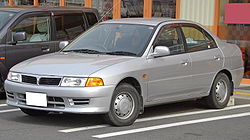
Also called Mitsubishi Signo (Venezuela)[13]
Mitsubishi Virage (Taiwan)
Mitsubishi Mirage (north america)Production 1995–2000
(still in production in Venezuela and India)Assembly Tiruvallur, Tamil Nadu, India
Barcelona, Anzoategui, Venezuela
Cainta, Rizal, Philippines
Laem Chabang, ThailandBody style 2-door coupé
4-door sedan
4-door station wagonLayout Front engine, front-/four-wheel drive Platform CK1A–CM8A Engine 1.3 L 4G13 I4
1.5 L SOHC 4G15 I4
1.5 L DOHC 4G15 I4
1.6 L SOHC 4G92 I4
1.6 L DOHC 4G92 Mivec I4
1.8 L 4G93 I4
1.8 L DOHC 4G93 turbo I4
1.8 L 6A11 V6
2.0 L 4D68 diesel I4Transmission 5-speed manual
4-speed automatic
4-speed semi-autoWheelbase 2,500 mm (98.4 in) (sedan)
2,440 mm (96.1 in) (coupe)Related Mitsubishi Lancer Evolution
Mitsubishi Mirage
Soueast LioncelIn 1995, the Lancer was renewed for its Seventh generation, building on the earlier model's format. Apart from the Evo models' continuation, it did not depart from the established Lancer formula. A sedan and wagon (Libero in Japan) were offered, with a related Mirage model. The coupé continued as the Mirage Asti in Japan, known as the Lancer Coupé elsewhere. A turbocharged GSR version continued to be sold until the end of the 1990s. This platform was also the basis for the Mirage, as it was known in North America and various other markets.
From 1996 to 2004, the Mitsubishi Carisma, developed in Europe, replaced the Mitsubishi Lancer in some markets.
It is of note, that the Lancer Evolution V was the only Lancer Evolution to gain Mitsubishi the WRC constructors championship. However, driver Tommi Makinen was able to claim four WRC driver's championships for himself, in 1996–1999, driving Mitsubishi's Lancer Evolution III, IV, V & VI.
Australia (1996–2004)
In Australia, the Seventh sold from 1996–2004. It was designated as the CE series. Like the previous generation, it was available in a variety of body styles, which helped to cater for a more broad audience. The introduction of a sporty MR coupe helped to target this model directly towards a younger audience.
The station wagon continued on as a CE model, even though it was essentially carried over from the previous generation. This model had an unusually long model run, becoming increasingly uncompetitive as the years went by and often heavily discounted by dealers. Towards the end of its model run, Mitsubishi introduced some limited edition models (based on the GLi) to remain competitive with its rivals, these editions featured extras such as sports interiors, alloys and body kits off higher spec models. Generally, this generation sold well throughout its production run.
It should be noted that despite the introduction of the eighth generation Lancer Cedia in 2000, the CE series continued to be sold alongside it until mid-2004. The sedan was available in GLi trim, until it was finally discontinued in 2003. The coupe was facelifted and now only available in GLi and MR trims.
Due to its appearance, affordability, and the rise in status of the Lancer Evolution, this generation was quite popular with young car enthusiasts and the aftermarket modified Japanese car scene. Some popular modifications include exhaust systems, suspension, after market stereos and replica Evolution body kits.
Series I (96-98) and Series II (98-99)
- GLi - 2-door coupe and 4-door sedan. Powered by a 4 cylinder, 1.5 L engine (4G15 SOHC - 69 kW)
- GLXi - 2-door coupe and 4-door sedan. Powered by a 4 cylinder, 1.8 L engine (4G93 SOHC - 88 kW)
- MR - 2-door coupe. Powered by a 4 cylinder, 1.8L engine (4G93 SOHC - 86 kW)
- MR - 4-door sedan. Powered by a 4 cylinder, 1.8L MIVEC engine (4G93 SOHC - 141 kW)
- GSR - 4-door sedan. Powered by a turbocharged 1.8 L engine (4G93t DOHC - 141 kW)
- MXd - 4-door sedan. Powered by a turbodiesel 2.0 L engine (4D68T SOHC - 65 kW)
Series III (99-03)
- GLi - 2-door coupe (1.5 L or 1.8 L) and 4-door sedan (4 cylinder, 1.8 L)
- GLXi - 2-door coupe and 4-door sedan. Powered by a 4 cylinder, 1.8 L engine
- MR - 2-door coupe. Powered by a 4 cylinder (6 cylinder, 99-00), 1.8 L engine
Series IV (02-04) coupe update only
- GLi - Choice of 1.5 L engine (discontinued in 2003) or 1.8 L engine, 4 Cylinder
- MR - Powered by a 1.8 L engine, producing 86 kW (115 hp) & 163 N·m (120 lb·ft) of torque (1500-4500 rpm) out of a 4 cylinder
Philippines (1996–2002)
- EL - 4-door sedan with 1.3 L carb engine (4G13 - 55 kW)
- GL - 4-door sedan with 1.5 L engine (4G15 - 65 kW)
- GLXi - 4-door sedan with 1.6 L SOHC engine (4G92 - 85 kW)
- GLX - 1999–2002 model 4-door sedan with 1.5 L carb engine
- GLS - 1999–2002 model 4-door sedan with 1.6 L Fuel injected engine
- MX - 1999–2002 model 4-door sedan top of the line with 1.6 L EFI 4G92 SOHC engine with INVECS automatic transmission.
- GSR - 2-door coupe (97-02) Powered by 1.6 L 4G92 SOHC engine
Indonesia (1997–2002)
comes in 2 types (1997–2002)
- GLXi - 4-door sedan with 1.6 L Fuel Injected Engine (4G92)
- SEi - 4-door sedan with 1.6 L Fuel Injected Engine (4G92) equipped with front, side and rear spoilers, airbags, foglamps, and rear garnish.
In late 2001, comes with a facelift model taken from Philippine version. One piece headlights, longer bumpers, vertical chrome grille, and 15" alloy wheels. also in two types: SEi and GLXi as mentioned above. This model discontinued at December 2002, and replaced by its successor Lancer Cedia.
Venezuela: Mitsubishi Lancer (1996–2004); Signo (2004-present)
In Venezuela the model was introduced in 1996 as the Mitsubishi Lancer featuring common characteristics mentioned above, until 2004. This generation was then renamed the Mitsubishi Signo and is assembled by the MMC Automotriz plant. It is sold alongside the eighth generation of the Lancer in Venezuela. Available Signo model variants are:
- GLi - 4-door sedan. FWD. Powered by a 1.3 L ECI-Multi engine (57 kW)
- Plus - 4-door sedan. FWD. Powered by a 1.6 L ECI-Multi engine
- Taxi - 4-door sedan. FWD. Powered by a 1.6 L ECI-Multi engine
India (1997-present)
In India the model was introduced in June 1998 as the Mitsubishi Lancer and is assembled by the Hindustan Motors Limited.[14] Available model variants are[15]
- LX - 4-door sedan. FWD. Powered by a 1.5 L ECI-Multi engine (87 PS)
- LX - 4-door sedan. FWD. Powered by a 2.0 L IDI Diesel engine (68 PS)
Eighth generation (2000–2007)
Eighth generation 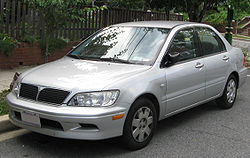
Also called Mitsubishi Lancer Cedia
Mitsubishi Lancer Classic (Russia)
Soueast Lioncel II (China & Ukraine)
Mitsubishi Virage (Taiwan)
Mitsubishi CediaProduction 2000–2007 Assembly China
Tiruvallur, Tamil Nadu, India
Barcelona, Anzoátegui, Venezuela
Laem Chabang, Thailand
Cainta, Rizal, Philippines
Yangmei, Taoyuan, Taiwan[16]Predecessor Mitsubishi Carisma (Europe)
Mitsubishi Mirage (USA)Body style 4-door sedan
5-door station wagonLayout FF layout Platform CS2A–CS5W Engine 4G13 1.3 L SOHC I4
4G18 1.6 L SOHC I4
4G93 1.8 L DOHC I4
4G93 1.8 L DOHC I4 GDI Turbo
4G94 2.0 L SOHC I4I4
4G63 2.0 L DOHC I4
4G69 2.4 L SOHC MIVEC I4Transmission 4-speed automatic
4-speed semi-auto
5-speed manual
invecs III CVTWheelbase 2,600 mm (102.4 in) Length 4,495–4,605 mm (177.0–181.3 in) Width 1,695 mm (66.7 in) Height 1,375–1,425 mm (54.1–56.1 in) Related Mitsubishi Lancer Evolution, Mitsubishi Outlander The year 2000 saw the release of the eighth-generation Lancer Cedia in Japan (meaning Century Diamond); though in most markets the seventh generation Lancer continued, built at Mitsubishi's Mizushima plant in Japan. The new model was available in sedan and station wagon forms. The Mirage, apart from the export models, became a different car in Japan that was unrelated to the Lancer. In Europe, the Lancer was not offered in some countries, being too close to the size of the Dutch-built Carisma, so the Evo VII model sold there bore the Carisma name. It is still sold in Japan where the ninth generation Lancer is known as "Galant Fortis".
In North America, the Lancer Cedia was introduced in 2002 as a direct replacement for the Mirage. It is powered by a 2.0 L 4G94 engine producing 120 hp (92 kW) and 130 lb·ft (176 N·m) of torque.
In Australia, the eighth generation Lancer was introduced as the CG series in July 2002 with the 2.0 L 4G94 engine. It was introduced as a replacement for the seventh generation sedan, and was sold alongside the popular seventh generation coupe.
Mid-generation facelift
In 2004, a heavily restyled Lancer surfaced with a front facia that brought it into line with the Mitsubishi corporate look, as well as a restyled rear, to further differentiate itself from the Lancer Evolution and for a more modern appearance. The car's grille was then redesigned again in 2006.
North America
In North America, additional minor styling changes also occurred for 2005 and 2006. For the 2005 model year, the grille was changed to include more fins to reflect a closer similarity to the North American Galant. For the 2006 model year, the fascia was changed again from a bridged fascia to one with an open vent after Mitsubishi received complaints from current owners regarding its similarity in appearance to General Motors Division Pontiac's corporate look, and to bring the appearance closer to its bigger brother, the Evolution.
In Mexico, the Lancer was available in DE, ES, LS and GS trims with a 2.0 L DOHC 4G63 engine. There were no estate versions: only the four-door saloon.
The National Highway Traffic Safety Administration (NHTSA) has determined crash test ratings of Lancer of different model years:[17]
Model year Model Type Frontal driver rating Frontal passenger rating Side driver rating Side passenger rating 4x2 Rollover 2002 Lancer 4-DR 




2004 Lancer 4-DR 




2006 Lancer 4-DR 




2007 Lancer 4-DR 




Ralliart
In addition to the facelift, North America received two additional models to the Lancer line in 2004 – Sportback and Ralliart. The latter slated in between the base and high performance Evolution model. Both the Sportback and Ralliart had high levels of equipment, based on the Australian Lancer VR-X. The main difference being that these cars came equipped with Mitsubishi's 2.4L 4G69 engine (rated at 160 hp (119 kW)/162 lb·ft (220 N·m) for the Sportback, and 162 hp (121 kW)/162 lb·ft (220 N·m) for the Ralliart), included a new, stiffer suspension package that improved handling and lowered the cars stance by 1 centimeter, 16" alloy wheels, front bucket seats borrowed from Japan's Mitsubishi Evolution GT-A, fog lamps, and a new aerodynamic ground package. The Ralliart also came equipped with a cosmetic rear deck spoiler, and clear rear tail lights. The Sportback was equipped with a 4-speed INVECS-II automatic transmission, with no option for a manual transmission, while the Ralliart came with a 5-speed manual transmission with an option for the 4-speed automatic. The Sportback was also available in the lower spec LS trim.
Due to[citation needed] Mitsubishi's deteriorating financial situation and slow sales, the Lancer Sportback wagon was cancelled in the United States one year after its release. But the Mitsubishi Lancer wagon was sold in Canada, Japan, Europe, Australia and New Zealand, and was available in at least the latter two until 2009.
Australia
The 2003 facelift, designated the CH series,[18] introduced a heavily updated VR-X, which included new 16" alloys, stiffer suspension, body styling kit, and gear shifter borrowed from the Lancer Evolution. In 2004, the new Lancer wagon was introduced as a direct replacement for its ageing predecessor.
In August 2005, all Lancers were upgraded to the 2.4 L 4G69 engine, producing 115 kW (154 hp) and 220 N·m (162 lb·ft) of torque. The upgraded engine also saw a change in trim levels and upgraded equipment—the ES and LS models now featured a more upmarket looking black interior, while the VR-X gained a new black grille to closer resemble the Lancer Evolution IX. The equipment levels of all models were also upgraded, with the LS and VR-X gaining climate control, and a premium audio system sourced from the luxury Mitsubishi Verada. The Exceed model was discontinued, and all updated models now used JDM sized rear bumpers instead of the larger USDM sized versions. Additionally, the wagon also saw these changes; and as of 2007, continues to be sold alongside the sedan.
The ES and LS models were given a minor facelift for the 2007 model year; this time gaining the same front grille as the US models, and putting it into line with the current corporate look—similar to that of the Colt and the locally built 380. Prior to the introduction of the all-new ninth generation Lancer, a limited edition ES model dubbed 'Velocity' went on sale. This package included VR-X grill, rear spoiler, leather/alcantara bolsted seats, sports pedals, 15" OZ alloy wheels and chrome exhaust tip—all for the same price as the previous standard ES.
Other markets
In Japan, the Lancer Cedia was offered with many different trim levels and engines, including some options never exported. It was also one of the first models to use the INVECS-III CVT transmission. There was also a Ralliart version of the sportswagon which was powered by a turbocharged 1.8 L GDI engine. As of 2009, the eighth generation Lancer sedan is still being sold alongside the new ninth generation, which is known in the home market as the Galant Fortis.
In Pakistan, this variant was launched in 2005 with cosmetic changes from the front and the back. Thai production was switched to the new model, and in all markets except for India the seventh-generation model was no longer marketed, four years after the Cedia's introduction. India received the new Lancer in 2006, known locally as the Mitsubishi Cedia to distinguish it from the previous version which is still assembled and sold as the Lancer. In Malaysia, the Lancer was made available after Mitsubishi had sold all its shares in Malaysian carmaker Proton, marking the return of Mitsubishi in Malaysian market after being absent since 1985 due to the agreement with Proton. The Lancer sold in Malaysia was powered by the 4G18 engine which also powered the early 1.6 Proton Waja model. In the Philippines, the Lancer underwent a facelift, now without the central semi-triangle in the grille. It is offered in 2 trims, the base GLX with a 5-speed manual and the GLS with an all-new INVECS-III CVT with manual override. Both are powered with an l4 1.6L 4G18 SOHC engine.
In some European markets, the Lancer began to take the place of the Carisma in 2004. It is powered by a 1.3 L SOHC 16valve 4G13 engine producing 82 PS (60 kW) at 5,000 rpm and 120 Nm of torque at 4,000 rpm, 1.6 L SOHC 4G18 engine producing 98 PS (72 kW) at 5,000 rpm and 150 Nm at 4,000 rpm and a 2.0 L DOHC 4G63 producing 135 PS (99 kW) at 5,750 rpm and 176 Nm at 4,500 rpm.
Ninth generation (2007–present)
Ninth generation 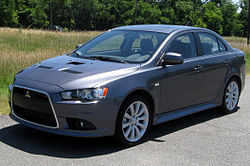
Also called Galant Fortis (Japan)
Lancer Fortis (Taiwan)
Lancer iO (Taiwan)
Lancer EX (Indonesia, El Salvador, Panama, Thailand, Hong Kong, Singapore, Sri Lanka, Philippines & Middle East)
Lancer Serie R (Chile)Production 2007–present Body style 4-door sedan (GS41)
5-door hatchback (GS44S)Layout Front engine, front-/four-wheel drive Platform CY2A–CZ4A Engine 4B12 2.4 L DOHC I4,
4B11 2.0 L DOHC I4,
4B10 1.8 L DOHC I4,
4A91 1.5 L DOHC I4,
VW 2.0 L Di-D DieselTransmission 5-speed manual
INVECS-III CVT automatic
INVECS-II 4-speed Automatic (Singapore 1.5l variant)
6-speed twin-clutch transmission (Lancer Ralliart)Wheelbase 2,615 mm (103.0 in) Length 4,570 mm (179.9 in)
Sportback: 4,585 mm (180.5 in)Width 1,760 mm (69.3 in) Height 1,490 mm (58.7 in)
Sportback: 1,515 mm (59.6 in)Curb weight 1,320–1,593 kg (2,900–3,510 lb) Related Mitsubishi Lancer Evolution
Chrysler Sebring
Dodge Avenger
Proton InspiraIn 2005, Mitsubishi revealed the Concept-X model car at the Tokyo Motor Show and its Concept-Sportback model at the Frankfurt motor show. The new Lancer is based on these two concepts. The new Lancer was officially revealed in January 2007 at the Detroit Motor Show and went on sale in North American markets on March 2007 as a 2008 model. New Lancer features Mitsubishi's next-generation RISE safety body.
As per Mitsubishi's heritage of the next generation Lancer this is their ninth generation.[19]
America
For the United States, the new Lancer was initially available in DE, ES, and GTS trim levels.[20] DE, ES, and GTS models are powered by a GEMA based 4B11, 2.0 litre DOHC engine producing 152 hp (113 kW) (except for California models which have been detuned to 143 hp (107 kW) to meet regulations). Transmission options include a brand new CVT, sourced from Jatco (code: F1CJA), alongside a regular 5-speed manual sourced from Aisin AI (code: F5MBB). GTS models get a 6-speed paddle shift version of the CVT.
In Canada, a fourth model (SE) was introduced to the Lancer lineup late in the model year. The SE model is a cross between the ES and GTS models. It includes the skirt package similar to the GTS, a rear spoiler, and unlike the GTS model, the SE includes a sunroof. Features not included in the SE model that are found in the GTS are the FAST key, Bluetooth hands-free cell phone interface, automatic climate control, Rockford Fosgate sound system, carbon fiber trim pieces, leather wrapped steering wheel and shift knob, and 18" wheels.
For U.S. markets, starting with the 2009 model year, an ES-Sport version was released similar to the SE model for the Canadian market. Externally the ES-Sport is similar in appearance to the GTS' skirts, spoiler, mirrors, etc. (with the exception of the wheels, the ES-Sport retains the ES wheelset). The ES-Sport also uses the ES 2.0 liter engine.[21]
For 2009, the GTS is powered by a 2.4 L 4B12 engine producing 168 hp (125 kW) and 167 lb·ft (226 N·m).[21]
The five-door hatchback version, known as the Sportback, was introduced for the Canadian market in spring 2009, and in the U.S. for the 2010 model year in late summer 2009.,[22][23]
Chile
To differentiate it from the previous model, still on sale, this generation Lancer is marketed as Lancer Serie R in Chile.
El Salvador
Because the previous generation is still on sale, this generation Lancer is marketed, depending on the engine and trim, as Lancer EX or Lancer GT in El Salvador.
Australia
The Lancer was released in Australia in October 2007, designated the CJ series and is initially available in ES, VR and VRX trims. The ES included cruise control, driver, passenger and knee airbags, stability and traction control as standard. The VR adds alloy wheels, foglights, side skirts, boot lip spoiler, rain-sensing wipers, automatic headlights, 6-disc CD changer, as well as curtain and side airbags. The VRX gets extra skirts, a larger rear spoiler, 18-inch alloys and a premium Rockford Fosgate sound system. All three models shared the same 4B11 2.0-litre engine and can be had with manual or CVT. A Ralliart version has been introduced later, with a turbocharged version of the same engine, 4WD and paired with a 6-speed twin-clutch gearbox. The Evo X also joins the lineup afterwards. In late 2008, another variant, the Aspire, has been introduced. It includes more luxury features and has a 2.4-litre 4B12 engine mated only to the CVT. The VRX also gets the engine upgrade and can still be had with a manual.
The Sportback body followed the sedan and can be had in ES, VR, VRX and Ralliart trims. Special models have also been introduced, such as the Platinum Edition, which is based on the VR but added a chrome grille and window surrounds (sedan only), MMCS satellite navigation and Bluetooth compatibility for handsfree mobile phone usage. A new RX version is derived from the ES but comes with standard alloy wheels. Another model introduced in 2010 was the SX coming with factory alloys, leather steering wheel & gear shifter as well as factory spoiler.
Asia
With the exception of the Lancer Evolution X, the Lancer is marketed as the Galant Fortis (Latin for strong, steadfast and courageous) in the Japanese domestic market.[24] It comes in 3 trim levels: Exceed, Super Exceed, and Sport.[25]
The new Lancer was released on September 15, 2007 in Taiwan and has been named Lancer Fortis. It's powered by a 4B11, 2.0 litre DOHC engine outputting 157 hp (117 kW) and the transmission is a 6-speed (fixed gears in sport mode) version of the CVT. However, unlike other Lancer models in USA and Japan, Mitsubishi has changed the front and rear ends to make it look like a family car.[26]
Due to popular demand of the 7th-gen Lancer in Singapore, it will continue to be sold alongside the new Lancer which will be called the Lancer EX to differentiate itself from the former. The 1.5l, 2.0l and the GTS (marketed as the GT) variants are available in Singapore. For MY2009, the GT has been refreshed all around with updated front grill, darkened clear tail lamps, and chrome lining with an additional floor console internally. Rear brakes has also been upgraded for the 2.0 variants to disc brakes for better stopping power.
In Malaysia, only the GTS is offered and is marketed as the GT. However, Proton has renewed cross-licensing and technology transfer agreements with Mitsubishi as of October 2008, and a second-generation Proton Waja replacement called the Proton Inspira[27] (codenamed the Proton P3-90A[28]) will be a rebadged ninth generation Lancer with 3 variants - a 1.8 manual, a 1.8 CVT automatic and a 2.0 CVT automatic.[29]
In Indonesia, like Malaysia, only the GTS is sold and is badged as the GT using the new 2.0L engine and is sold alongside the Evolution X, and like Singapore the previous generation Lancer is still sold, marketed as the Lancer Cedia using the same 1.8L engine as the 7th generation Lancer. With the agreement with Proton finalized on October 2008, it is expected that the Lancer-based Waja will be exported to Indonesia.
Hong Kong received its unique edition of the Lancer in 2008, dubbed the Lancer 2.0. The car comes in two trim levels, without a name for either of them. Both are equipped with the 4B11 2.0 4 cylinder engine, 7 airbags, 8 speaker stereo system (manufacturer not known), Adaptive Front-lighting System (AFS) with HID as well as 18" alloy wheels. The upper trim has Ralliart style body kit which includes a revised front bumper, side skirt, rear bumper with diffuser and the addition of a correct-to-Evolution-X rear spoiler,while the lower trim make do without the abovementioned features.
In Philippines the Lancer arrived in Mid 2008 known as the Lancer EX to differentiate it from the 7th-generation Lancer still sold in the Philippines. For the 2010 MY, the Lancer EX underwent a facelift, and is now available with 4 trims, the Ralliart paired to the 6-speed TC-SST, which is essentially the Lancer Ralliart from the USDM, the GT-A, now with a redesigned front grille resembling the Lancer Ralliart from the USDM, the GT, essentially identical to the GT-A but is paired to a 5-speed manual, the GLS which is essentially identical to the USDM ES model but with dual SRS airbags and standard front foglamps, and the GLX, which is essentially identical to the USDM DE, but with the same rims as with that of the GLS and with dual SRS airbags. All models sport clear-type black taillamps, ABS, EBD and share the same 2.0L 4B11 MIVEC powerplant, with the Ralliart's engine similar to the USDM Ralliart.
Europe
In Europe, a 103 kW (140 PS; 138 bhp) 2000 cc diesel model is also available which is built by Volkswagen.
Republic of Ireland
In the Republic of Ireland, the specifications are different to those sold in the United Kingdom. The Lancer is available in five-door hatchback (Sportback) or four-door saloon bodystyles.
Engines are 1.5L 109 bhp 4-cylinder petrol (Republic of Ireland spec guide), and the 1.8 petrol and 2.0 TDI models available in the United Kingdom are unavailable; but are popular grey imports. Trim levels are Base for the sedan, and Invite for the Sportback. It is a more basic version compared to other European markets.
Lithuania
In Lithuania (Lietuva) the Lancer is available as both the Sportback (hatchback) and sedan bodystyles. Engines are 1.5L 109 bhp and 1.8L DOHC 136 bhp 4-cylinder petrol engines; Volkswagen's TDI version is not available there. Trim levels are Inform, Inform +, Invite and Intense, with the sedan being available in 1.5 Inform, 1.8 Inform and 1.8 Inform + versions, and the hatchback models available as 1.8 Inform +, 1.8 Invite and 1.8 Intense. The Ralliart model is unavailable due to the Mitsubishi Lancer Evolution being offered in Lithuania; this is identical to the versions sold on the Continent, except with raised ground clearance for Lithuania and Eastern European roads.
Lancer Ralliart
A detuned and cheaper version of the Evo X was announced at the 2008 Detroit auto show. This model became available for purchase in the United States in October 2008. 177 kW (237 hp), 343 N·m (253 lb·ft) of torque.
For 2009, the Ralliart is available exclusively with the TC-SST transmission,[30] although Mitsubishi has suggested the possibility of a 5-speed transmission at a later date. The TC-SST transmission equipped in the Ralliart offers 2 modes (Normal, Sport) rather than the 3 modes the same transmission offers in the Lancer Evolution X MR (Normal, Sport, S-Sport). The car also includes a simplified version of the Evolution X's AWD system (taken directly from the EVO IX), with a simple "mechanical limited slip" rear differential.[31] According to Edmunds.com the Ralliart model underperformed the GTS in certain tests, including the skidpad, slalom, and braking distance. However, the Ralliart outperformed the GTS in other tests, including 0-60 and the quarter mile.[32]
See also
- Mitsubishi Racing Lancer
- Mitsubishi Lancer Evolution
- Mitsubishi Lancer 1600 GSR
- Mitsubishi Lancer WRC
- Mitsubishi Lancer Cargo
References
- ^ "All new 2008 Lancer" (PDF). AllnewLancer.ca. http://www.allnewlancer.ca/EN/LancerPreLaunch.pdf.
- ^ "Mitsubishi Lancer (Chrysler LB Lancer Liftback )". GoAuto. John Mellor. http://www.goauto.com.au/mellor/mellor.nsf/carfamilytree?ReadForm&ID=D253F98B4648D77ACA257125001A13FB. Retrieved 2010-10-08.
- ^ James M. Flammang (1994). Standard Catalog of Imported Cars, 1946-1990. Iola, WI: Krause Publications, Inc.. pp. 503–504. ISBN 0-87341-158-7.
- ^ Car Graphic: Car Archives Vol. 11, '80s Japanese Cars. Tokyo: Nigensha. 2007. p. 214. ISBN 978-4-544-91018-6.
- ^ a b Long, Brian (2007). Mitsubishi Lancer Evo: The Road Car & WRC Story. Dorchester: Veloce Publishing Ltd. ISBN 1-84584-055-0. http://books.google.com/?id=8ZkuDYyI8NUC.
- ^ CG Car Archives '80s, p. 207
- ^ Auto Katalog 1984. Stuttgart: Vereinigte Motor-Verlage GmbH & Co. KG. 1983. pp. 115–116, 226–227.
- ^ CG Car Archives '80s, p. 211
- ^ Mastrostefano, Raffaele, ed (1990) (in Italian). Quattroruote: Tutte le Auto del Mondo 1990. Milano: Editoriale Domus S.p.A. p. 545.
- ^ "1990 Mitsubishi Lancer GL 5-dr hatch". GoAuto. John Mellor. http://www.goauto.com.au/mellor/mellor.nsf/story2/749C6CCBD3FB17B9CA256D4B0002CD39. Retrieved 2010-11-04.
- ^ "Mitsubishi Lancer CC Lancer 1992-1996". GoAuto. John Mellor. http://www.goauto.com.au/mellor/mellor.nsf/carfamilytree?ReadForm&ID=37E89C11E59B2ACDCA257125001A13FF. Retrieved 2010-11-04.
- ^ "NRMA Car Review - Mitsubishi Lancer CC". mynrma.com.au. https://www.mynrma.com.au/cps/rde/xchg/mynrma/hs.xsl/mitsubishi_lancer_cc_1996_car_review.htm. Retrieved 2008-12-30.
- ^ "Signo". mitsubishi-motors.com.ve. http://mitsubishi-motors.com.ve/cms/index.php?option=com_content&task=view&id=370&Itemid=26. Retrieved 2010-07-28.
- ^ "Mitsubishi. Mitsubishi In India". Car-cat.com. http://car-cat.com/firm-705.html. Retrieved 2010-07-28.
- ^ "Mitsubishi Lancer | Technical Specifications". Mitsubishi Motors. http://www.mitsubishi-motors.co.in/lancer/specs.php. Retrieved 2010-07-28.
- ^ "Facts & Figures Mitsubishi Motors Corporation 2001". Mitsubishi Motors. http://www.mitsubishi-motors.com/corporate/ir/share/pdf/e/fact0109.pdf. Retrieved 2011-03-22. "Production facilities outside Japan - China Motor Corp. (CMC), Yang Mei Factory, 49 Shio Tsai Rd., Yang Mei Taoyuan, Taiwan"
- ^ "1990-2010 Search Results by Model". NHTSA.GOV. http://www.safercar.gov/Vehicle+Shoppers/5-Star+Safety+Ratings/1990-2010+Vehicles/Search-Results?searchtype=model&make=MITSUBISHI&model=LANCER&year=. Retrieved 2011-03-17.
- ^ "CH Lancer Prices Released". Autoweb.com.au. http://www.autoweb.com.au/cms/A_55681/title_CH-Lancer-Prices-Released/newsarticle.html. Retrieved 2008-12-30.
- ^ "Mitsubishi New Lancer". New-lancer.com. http://www.new-lancer.com/en/index.html. Retrieved 2010-04-03.
- ^ "2008 Mitsubishi Lancer Review". JB car pages. http://www.jbcarpages.com/mitsubishi/lancer/2008/. Retrieved 2009-02-25.
- ^ a b "2009 Mitsubishi Lancer Review". JB car pages. http://www.jbcarpages.com/mitsubishi/lancer/2009/. Retrieved 2009-02-25.
- ^ "2010 Mitsubishi Lancer Sportback coming to America five+door style". Jalopnik. http://jalopnik.com/5142979/2010-mitsubishi-lancer-sportback-coming-to-america-five+door-style.
- ^ "First Drives " First Drive: 2009 Mitsubishi Lancer Sportback". CanadianDriver. 2009-03-30. http://www.canadiandriver.com/2009/03/30/first-drive-2009-mitsubishi-lancer-sportback.htm. Retrieved 2010-04-03.
- ^ "Mitsubishi unveils "design study" shots of the production Evo X". Autoblog. http://www.autoblog.com/2007/04/26/mitsubishi-unveils-design-study-shots-of-the-production-evo-x/.
- ^ "Mitsubishi Galant Fortis Launched". World Car Fans. http://www.worldcarfans.com/2070823.003/mitsubishi-galant-fortis-launched-ja.
- ^ "Taiwanese Market Mitsubishi Lancer Fortis". PaulTan.org. http://paultan.org/archives/2008/03/19/taiwanese-market-mitsubishi-lancer-fortis/.
- ^ Tan, Paul. "Proton Inspira now officially open for bookings". Paultan.org. http://paultan.org/2010/10/14/proton-inspira-now-officially-open-for-bookings/. Retrieved 2011-07-19.
- ^ "Proton Inspira". paultan.org. October 2010. http://paultan.org/2010/10/13/proton-p3-90a-based-on-mitsubishi-lancer-preview-drive/. Retrieved 14 October 2010.
- ^ "PROTON ENTERS INTO PRODUCT COLLABORATION WITH MITSUBISHI MOTORS CORPORATION, JAPAN.". Bursa Malaysia. December 12, 2008. http://announcements.bursamalaysia.com/EDMS%5Cannweb.nsf/LsvAllByID/482568AD00295D074825750E0005C2E7?OpenDocument. Retrieved 16 March 2009.
- ^ "2009 Mitsubishi Lancer Specs". JB car pages. http://www.jbcarpages.com/mitsubishi/lancer/2009/specs/. Retrieved 2009-02-25.
- ^ "2008 Detroit Auto Show: 2009 Mitsubishi Lancer Ralliart". Edmunds. http://www.edmunds.com/insideline/do/News/articleId=124308.
- ^ "Testing the 'Tweener'". Inside Line. http://www.edmunds.com/insideline/do/Drives/FullTests/articleId=127586. Retrieved 2008-06-22.
External links
- Worldwide launch site
- Mitsubishi Lancer official site
- Mitsubishi Lancer global website
- Mitsubishi Lancer official history from archive.org (archived November 22, 2004)
- Wikicars: Mitsubishi Lancer
Type 1960s 1970s 0 1 2 3 4 5 6 7 8 9 0 1 2 3 4 5 6 7 8 9 Kei sedan Minica Minica 70-73 Minica F4 Minica 5 Minica Ami 55 Minica Skipper Kei truck/ commercial 360 Van/Pickup Minica Van Minica
5 VanMinica 55 Van Minicab Minicab EL Minicab W Minicab 5 Minicab Wide 55 Subcompact 500 Colt 600 Colt 800 Colt 1000F Colt 1100F/11-F Compact Colt 1000 Colt 1100 Colt 1200 Lancer Lancer EX Colt 1500 (Colt) Galant Galant Galant Σ Sport coupé Galant FTO Lancer Celeste Galant GTO Galant Λ Executive Debonair Mitsubishi Motors North America timeline Type 1980s 1990s 2000s 2010s 0 1 2 3 4 5 6 7 8 9 0 1 2 3 4 5 6 7 8 9 0 1 2 3 4 5 6 7 8 9 0 1 Subcompact Cordia Tredia Mirage Mirage Mirage Precis Compact Mirage Lancer Lancer Galant Galant Sigma Galant Diamante Sport compact Eclipse Eclipse Eclipse Eclipse Lancer Evolution Lancer Evolution Mid-size Galant Galant Diamante Diamante Sports car Starion 3000GT Station wagon Space Wagon Expo Expo LRV Compact XUV Outlander Outlander Outlander Sport/RVR Mid-size XUV Endeavor Minivan Vanwagon Sport utility vehicle Montero Sport Montero Montero Montero Pickup Mighty Max Mighty Max Raider Categories:- Mitsubishi Motors vehicles
- Subcompact cars
- Compact cars
- Euro NCAP small family cars
- Vehicles with CVT transmission
- Front wheel drive vehicles
- Rear wheel drive vehicles
- All wheel drive vehicles
- 1970s automobiles
- 1980s automobiles
- 1990s automobiles
- 2000s automobiles
- 2010s automobiles
- Vehicles introduced in 1973
- Coupes
- Hatchbacks
- Sedans
- Station wagons
- Partial zero-emissions vehicles
Wikimedia Foundation. 2010.





